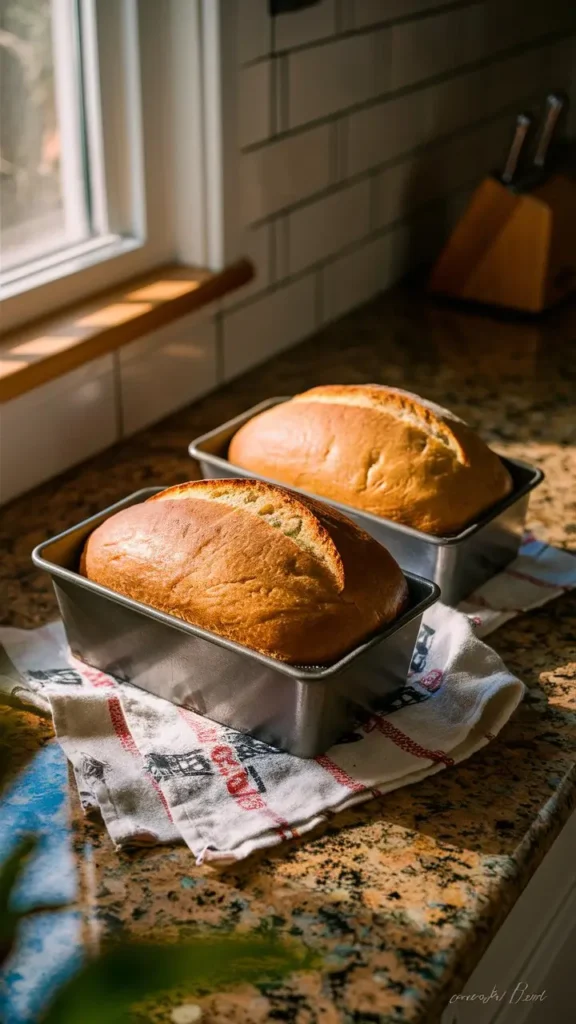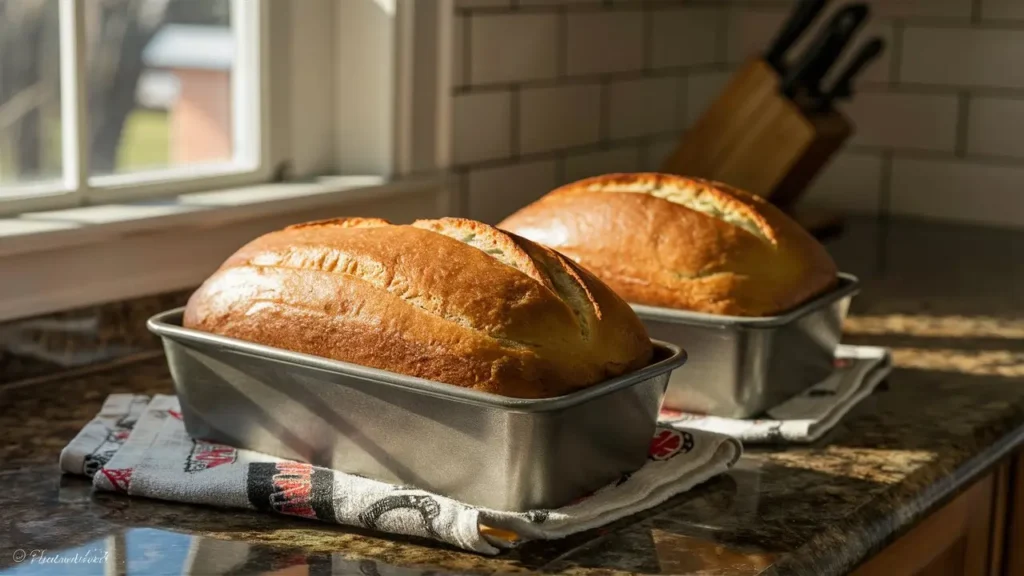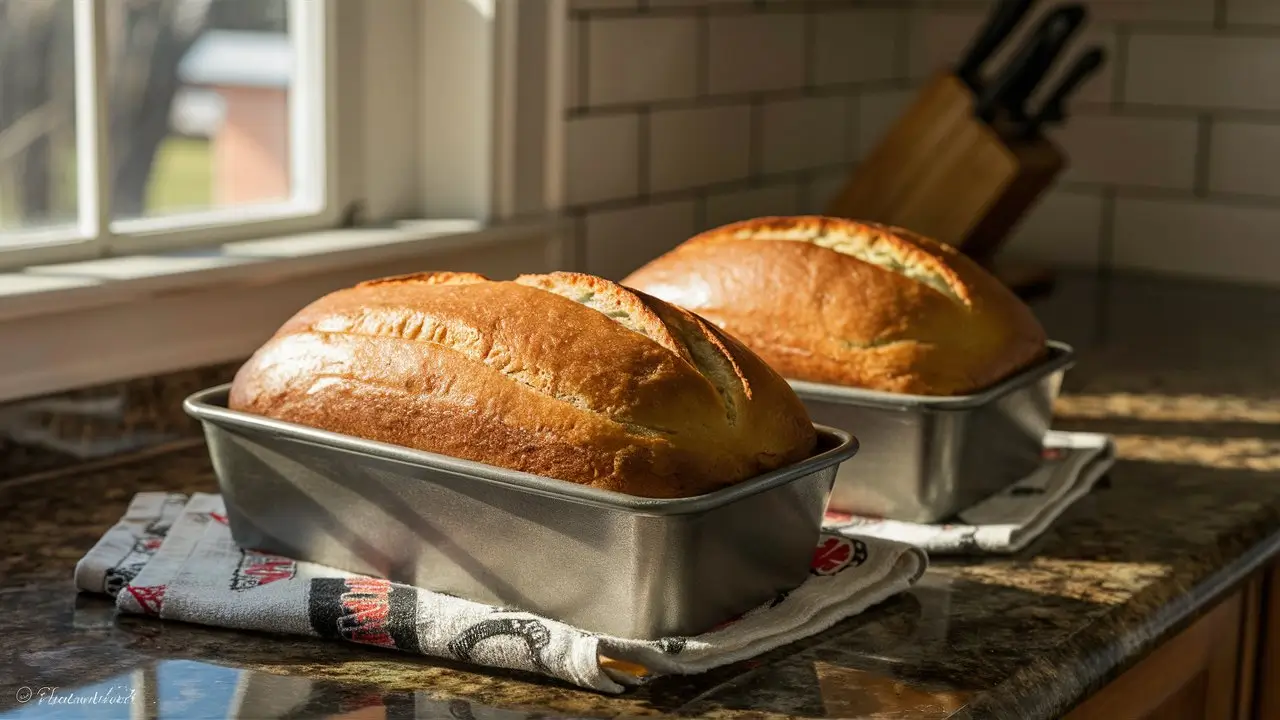Potato bread is a wonderfully soft and fluffy bread made with mashed potatoes blended into the dough. Known for its pillowy texture, extended shelf life, and rich flavor, it’s the perfect bread for sandwiches, toast, or enjoying warm with butter.
This old-fashioned recipe uses humble ingredients but delivers an outstanding loaf that rivals anything you’ll find at a bakery. Whether you’re new to bread baking or a seasoned home baker, potato bread is a must-try addition to your repertoire.

Why You Will Love This Recipe
-
Extra Moisture and Softness: Mashed potatoes make the bread incredibly tender and moist.
-
Longer Freshness: Stays soft for days without preservatives.
-
Versatile Uses: Ideal for toast, grilled cheese, or French toast.
-
Great for Beginners: Easier to knead and shape than standard white bread.
-
Customizable: Add herbs, cheese, or whole grains for variety.
What Is Potato Bread?
Potato bread is a yeasted loaf that includes mashed potatoes in the dough. The starches in the potato help retain moisture and give the bread a tender, chewy crumb. Unlike regular white bread, potato bread has a richer texture, slightly yellow color, and subtly sweet flavor.
It’s a staple in many cultures—from Irish potato farls to American-style sandwich loaves—and has been baked for generations as a hearty, affordable way to stretch ingredients and enhance flavor.
Ingredients List
Here are the basic ingredients needed to make one large loaf (or two smaller ones) of soft and delicious potato bread.
Dough:
-
1 cup mashed potatoes (plain, no butter or milk)
-
¾ cup warm water or potato cooking water
-
2 ¼ teaspoons active dry yeast (1 packet)
-
2 tablespoons sugar
-
3 tablespoons butter, softened
-
1 ½ teaspoons salt
-
3 ½ to 4 cups all-purpose or bread flour
Optional Add-Ins:
-
1 egg (for a richer dough)
-
1 tablespoon milk (for a softer crust)
-
Herbs, garlic powder, or shredded cheese
Timing & Servings
-
Prep Time: 25 minutes
-
Rise Time: 1 hour 30 minutes
-
Bake Time: 35–40 minutes
-
Total Time: Around 2 hours 30 minutes
-
Servings: 1 large loaf (10–12 slices)
Step-by-Step Instructions for Potato Bread
Step 1: Prepare the Mashed Potatoes
Peel and boil 1–2 medium Russet or Yukon Gold potatoes until soft. Mash until smooth. Do not add butter, milk, or salt. Let cool to room temperature before using.
Step 2: Activate the Yeast
In a small bowl, combine warm water (100–110°F), sugar, and yeast. Let sit for 5–10 minutes until foamy. This ensures the yeast is alive and active.
Step 3: Mix the Dough
In a large mixing bowl (or stand mixer), combine mashed potatoes, yeast mixture, butter, and salt. Gradually add flour, 1 cup at a time, until a soft dough forms.
Knead by hand for 8–10 minutes or in a stand mixer with a dough hook for 5–6 minutes, until smooth and elastic.
Step 4: First Rise
Place dough in a greased bowl, cover with plastic wrap or a damp towel, and let rise in a warm place until doubled in size—about 1 to 1½ hours.
Step 5: Shape the Dough
Punch down the dough and shape into a loaf. Place in a greased 9×5-inch loaf pan. Alternatively, shape into rolls or a round free-form loaf.
Step 6: Second Rise
Cover and let rise again until puffy and about 1 inch above the rim of the pan—around 30–45 minutes.
Step 7: Bake
Bake at 375°F (190°C) for 35–40 minutes, or until golden brown and sounds hollow when tapped. Internal temperature should reach 190°F.
Step 8: Cool and Slice
Let the bread cool in the pan for 10 minutes, then remove and cool completely on a wire rack before slicing.

Best Potatoes for Potato Bread
-
Russet Potatoes: High starch, low moisture. Great for bread structure.
-
Yukon Gold: Slightly buttery and creamy. Adds richness and a golden hue.
-
Avoid red potatoes or waxy varieties—they retain too much moisture.
Tip: Save the potato boiling water—it adds flavor and starch to the dough.
Different Ways to Shape Potato Bread
Potato bread is incredibly adaptable in form:
Loaf:
-
Perfect for sandwiches and toast. Use a loaf pan for even slices.
Rolls:
-
Shape into balls and bake in a greased baking dish. Great as dinner rolls.
Free-Form Boule:
-
Shape into a rustic round loaf and bake on a sheet pan or baking stone.
Buns:
-
Divide into equal portions for burger buns or sliders. Flatten slightly before baking.
Potato Bread Variations
Get creative with your potato bread by changing the flavor profile or adding mix-ins.
Cheesy Garlic Potato Bread:
-
Mix shredded cheddar and garlic powder into the dough.
Herb Potato Bread:
-
Add rosemary, thyme, or dill for a savory loaf.
Sweet Potato Bread:
-
Use mashed sweet potato instead of white potato for color and sweetness.
Whole Wheat Blend:
-
Replace 1–1½ cups of all-purpose flour with whole wheat flour.
Serving Suggestions
Potato bread is soft, slightly sweet, and ultra-versatile. Here’s how to enjoy it:
-
Toasted with butter and jam
-
Used for grilled cheese or BLT sandwiches
-
Served alongside soups or stews
-
Spread with cream cheese or peanut butter
-
Made into croutons or breadcrumbs for stuffing
It’s also perfect for French toast thanks to its soft crumb and subtle sweetness.
Make-Ahead and Storage Tips
Make-Ahead:
-
Prepare the dough, let it rise once, and refrigerate overnight. Shape and bake the next day.
Storage:
-
Store cooled bread in an airtight bag at room temperature for up to 4–5 days.
Freezing:
-
Wrap tightly in plastic and foil. Freeze whole or sliced for up to 3 months.
-
Thaw at room temperature or reheat slices in the toaster.
Nutritional Overview (Per Slice – Approximate)
-
Calories: 160
-
Carbs: 28g
-
Protein: 4g
-
Fat: 4g
-
Fiber: 1g
-
Sugar: 2g
Use whole wheat flour or add flaxseed for added fiber.
Common Mistakes and Fixes
Sticky Dough:
-
Too much moisture from the potato. Add more flour gradually.
Dense Loaf:
-
Under-kneading or not allowing enough rise time.
Cracked Top:
-
Dough rose too fast or dried out—cover well during proofing.
Bland Flavor:
-
Don’t skip salt! Potatoes need it for balance. Also, use quality butter and optional milk.
Potato Bread vs. Regular White Bread
Feature Potato Bread White Bread Texture Soft, moist, fluffy Light, airy Shelf Life Longer (due to moisture) Shorter Flavor Richer, slightly sweet Neutral Best Use Toast, sandwiches, dinner rolls Toast, sandwiches Ease of Making Slightly softer dough to handle Beginner-friendly
FAQs
Does potato bread taste like potatoes?
Not directly. It has a subtle sweetness and richness, but not a strong potato flavor.
Can I use leftover mashed potatoes?
Yes, but only if they’re plain—no butter, milk, or heavy seasoning.
Is potato bread gluten-free?
Not by default. It still contains flour with gluten unless you use a specific gluten-free blend.
Can I make it vegan?
Yes! Use olive oil instead of butter and skip the egg.
Can I use instant mashed potatoes?
Yes, but use less water and ensure the mixture isn’t too loose. Instant flakes work in a pinch.
Conclusion
Potato bread is more than just a twist on traditional bread—it’s a comforting, homemade favorite that’s surprisingly easy to make and deeply rewarding to eat. With its soft texture, gentle flavor, and impressive freshness, it works beautifully for everyday meals or holiday feasts.
Whether you’re serving it as a dinner side, using it for sandwiches, or enjoying a warm slice with butter, potato bread will earn a permanent place in your baking routine. Try a batch today and see just how much a little mashed potato can elevate a simple loaf.
